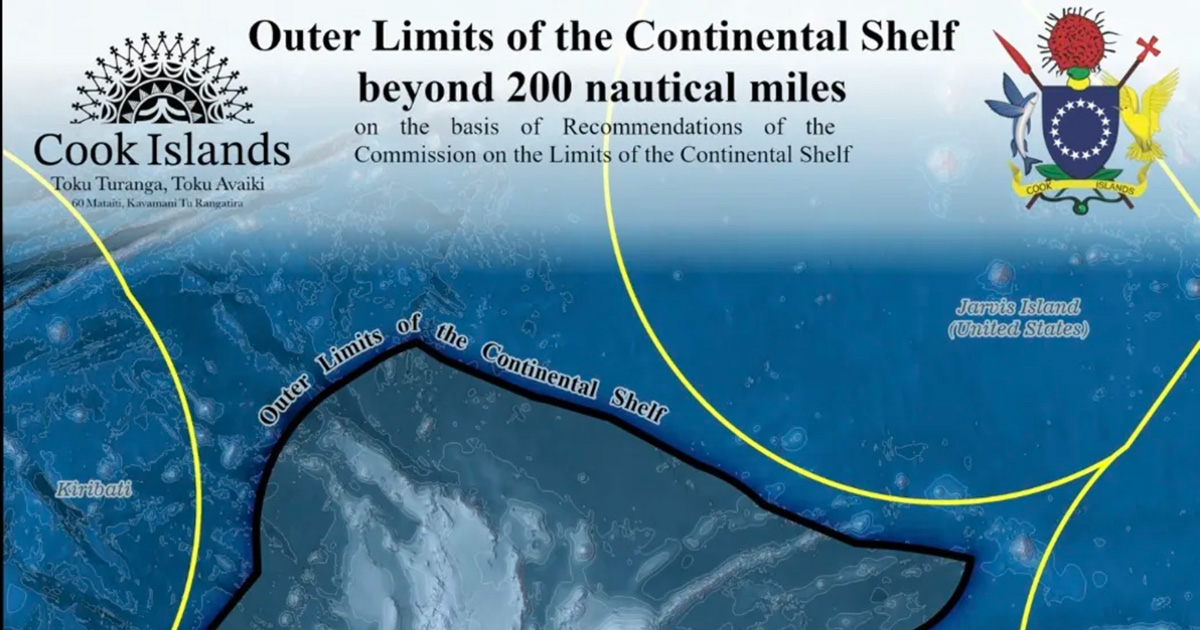This follows the formal receipt of recommendations from the Commission on the Limits of the Continental Shelf (CLCS) regarding the Cook Islands’ revised submission on the continental shelf limits beyond 200 nautical miles for the Manihiki Plateau.
The approval, stemming from a submission first made in 2009 and revised in 2021, expands the Cook Islands’ total maritime jurisdiction to 2,310,027 square kilometers.
The country’s Exclusive Economic Zone (EEZ) remains 1,960,027 square kilometers. The 350,000 square kilometers extension into the high seas north of the EEZ grants rights only to the seabed and subsoil resources, excluding the water column.
According to the Ministry of Foreign Affairs and Immigration (MFAI), this significant milestone clears the way for the Cook Islands to become the first Pacific Island country to finalize all of its maritime boundaries (the territorial sea, contiguous zone and the exclusive economic zone) and now, the outer limits of its continental shelf, in full accordance with the United Nations Convention on the Law of the Sea (UNCLOS).
“This is a proud and historic moment for the Cook Islands, as we celebrate our 60th Anniversary of Self-Governance,” said Joshua Mitchell, acting Secretary of MFAI.
“We have demonstrated that even the smallest of small island developing states can lead on ocean diplomacy and legal certainty, while upholding the highest standards of international law and ocean stewardship.”
Secretary of Infrastructure Cook Islands, Elizabeth Wright Koteka, added, “This result is a wonderful testament to the cooperation between our government, regional and international partners, since this journey started with our initial submission in 2009.”
According to MFAI, the Manihiki Plateau is a very large shield-shaped submarine geological formation located within the Cook Islands EEZ, which extends out into the area of international waters due north of the EEZ. It holds significant ecological, geological, and strategic importance for the Cook Islands. With the CLCS recommendations now received, MFAI says the Cook Islands can move forward and formally define, with final and binding effect under international law, the outer limits of its continental shelf in this area.
“In practical terms, the successful recognition of the Cook Islands claim represents an area of approximately 350,000 square kilometers of additional seabed ‘shelf’, extending into the high seas north of the EEZ—now forming part of the Cook Islands maritime jurisdiction.”
Professor Donald Rothwell from the Australian National University, an expert on the law of the seas convention, says the changes will allow the Cook Islands to stake a greater claim on the continental shelf and rights to deep-sea minerals.
“With the recognition of this entitlement, the Cook Islands will enjoy additional benefits over its continental shelf into this part of the Pacific, and it sits in an area just to the east of Kiribati and to the south of the United States claimed area with respect to American Samoa,” Professor Rothwell told ABC Pacific.
With the Cook Islands in a five-year exploration phase, started in 2022, for deep-sea mining of polymetallic nodules, Professor Rothwell agrees that this extension gives the country more territory to continue to explore and possibly exploit this resource in the future.
“I think that we’ll need to wait and see as to how the Cook Islands seeks to take advantage of this particular recommendation,” he said.
“Cook Islands has an additional 350,000 square kilometers of seabed which sits to the north of the current continental shelf and exclusive economic zone so the Cook Islands can legitimately under the provisions of its Continental Shelf Act seek to license and give permits to other mining operators to come in to explore and exploit that region entirely consistently with the provisions of the Law of the Sea Convention and without the need to have to work through the mechanisms that are currently being overseen by the International Seabed Authority. The reason being is that this is now being recognized as part of the sovereign entitlements of the Cook Islands over which it has recognized sovereign rights.”
MFAI acting secretary Mitchell said he was “not aware of any evidence that there are any substantial nodule deposits sitting atop these features that formed the basis of our claim.”
“What we do know, however, is that there are many areas within this extended continental shelf (ECS) claim that have very high species diversity and could otherwise be classified as vulnerable marine ecosystems,” Mitchell said.
“I would imagine that more careful research and study of this area will be required in order to properly inform our relevant Government agencies as to the kind of protection and management that will be necessary for it going forward.”
